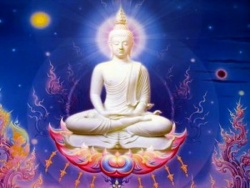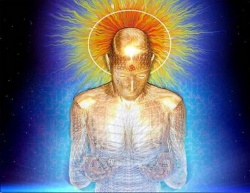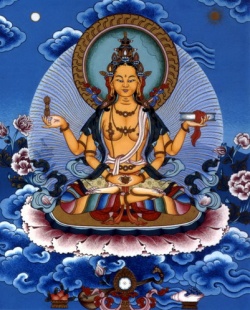Rites and Ceremonies
Written by: Julia Hardy
The rituals and ceremonies of Buddhism vary from country to country, and from area to area within a country. The Chinese monk Xuanzang, who visited India in the 7th century C.E., recounted that different Buddhist sects already had quite different ritual calendars, and even celebrated events in the Buddha's life, such as his birthday, on dates that were months apart.
In many Buddhist countries, the ritual calendar includes events that are celebrated in conjunction with other religions and/or national traditions. For example, the New Year is the biggest holiday of the year in many Asian countries, and activities last for a week or more. Traditions are followed, some specifically related to Buddhism, and others not, including a through housecleaning and settling of debts. Special foods are prepared, and some Buddhist temples will offer food to their constituents. In China it is customary for people to travel to visit their families for the holiday. On New Year's Eve in Japan, at midnight, Buddhist temples ring the temple bell 108 times; at the larger temples, huge crowds of people will attend this event.
The Buddha's birthday is the most widely observed Buddhist holiday, but it is celebrated on different days, with different rituals, in different countries. At some temples there will be a statue of the Buddha over which visiting devotees can pour water or a special tea. Some temples will offer a free vegetarian meal to all visitors. Buddhists may make charitable donations on this day, or they may purchase animals from slaughterhouses, release them, and provide for their welfare. In South Korea, Buddhist temples hang hundreds of paper lanterns, including some shaped like lotus flowers, throughout the temple grounds and connecting every building. Lay people make a small offering, in exchange for which the monks will write the names of the family on a merit certificate, which is then attached to a lantern. That evening, each family will seek out the lantern with their family's certificate attached, place a candle inside, and light it, and monks and lay people alike will stroll around enjoying the beauty of the brightly lit lanterns.
Some Buddhist countries celebrate the day of the Buddha's death and entry into nirvana, others celebrate the day of his enlightenment, and still others celebrate the day of his first sermon. Some Buddhist countries celebrate Sangha Day, which commemorates a day in the life of the historical Buddha when monks gathered to honor him. On this day, people bring food and gifts to the local temple. There may be days honoring other Buddhas or bodhisattvas, or significant Buddhists in the country's history; or there may be holidays commemorating special days in the history of Buddhism in a particular country, such as the Sri Lankan celebration of the coming of Ashoka's son Mahinda.
Buddhism is tied to life cycle events in some countries. For example, in Thailand, most young men will become monks for a period of time before marriage, as a part of their coming of age into manhood.
In East Asia in particular, people typically turn to Buddhist priests for funeral rites. In China and Japan, at specific intervals after the individual's death, people will often visit a temple to burn paper money and paper replicas of goods in order to provide a better afterlife for deceased family members. Though the names and customs differ, most Buddhist countries also have a holiday commemorating the deceased, during which spirits of the dead are believed to return to the world of the living. These spirits will be given food and other gifts before they are ritually returned to their proper abode.
Many Asian countries have some form of Buddhist pilgrimage that can be undertaken at any time of the pilgrim's choosing. Among the many pilgrimage sites in China is Putuo Shan, an island on the east coast of China devoted to temples honoring Guanyin. Other popular Chinese pilgrimage sites are Buddhist sacred mountains, each of which is believed to be the abode of a bodhisattva. Japan has a number of popular pilgrimages, such as the pilgrimage to the thirty-three temples of Kannon (Japanese for Guanyin). Families or retirees may visit one of these temples on a weekend over the course of several years, collecting special hand-drawn seals from each temple. Bus companies sometimes provide special buses for these temple visits.
Another famous Japanese pilgrimage is to the eighty-eight temples on the island of Shikoku. Some today travel by bus and may visit just a few temples as a social outing with religious overtones. To make the full pilgrimage takes about a year, and it will be normally be undertaken only by those with a deep personal or spiritual need. Some of the Shikoku pilgrims claim to have encountered the Buddhist monk Kukai along the way. Kukai was the founder of the Shingon Buddhist sect. He is said to have walked this route in his lifetime, founding temples and creating wells and reservoirs to provide fresh water for villagers along the way.
Festivals are a hugely popular tradition in Asia. There is textual and artistic evidence supporting the fact that large festivals were being held at stupas within a few centuries after the Buddha's death. The area would be decorated with flags and bright lights, the air would be filled with music and chanting, throngs of people would crowd into the area, and the atmosphere was joyous and friendly.
Today religious festivals are held throughout Asia. In some cases today, a festival may commemorate a historical moment, in others a religious one, and in many cases, representatives of several religions will be involved in preparing for and celebrating a festival. Often festivals are popular in particular regions, such as the Nebuta Matsuri in the Tohoku region of Japan, where locals may spend an entire year creating elaborate, lighted floats representing important moments in history or legend, Buddhist deities, or advertising a product. People gather along the route of the procession to cheer and shout along with the participants. This celebratory atmosphere remains an essential element of the festivals.


